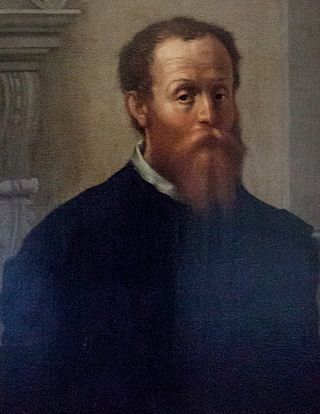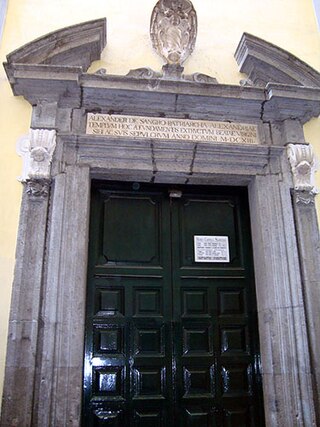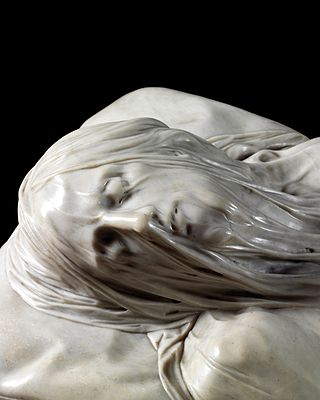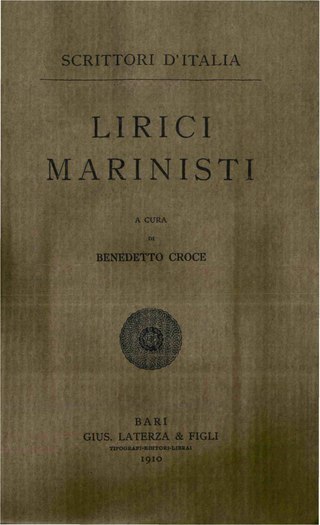
Baccio Bandinelli, was an Italian Renaissance sculptor, draughtsman, and painter.

The Basilica di Santa Croce is a minor basilica and the principal Franciscan church of Florence, Italy. It is situated on the Piazza di Santa Croce, about 800 metres southeast of the Duomo, on what was once marshland beyond the city walls. Being the burial place of some of the most notable Italians, such as Michelangelo, Galileo, Machiavelli, the poet Foscolo, the philosopher Gentile and the composer Rossini, it is also known as the Temple of the Italian Glories.

Pedro Álvarez de Toledo y Zúñiga was a Spanish politician. The first effective Spanish viceroy of Naples, in 1532–1552, he was responsible for considerable social, economic and urban improval in the city and southern Italian kingdom in general. He was the father-in-law of Cosimo I de' Medici, Grand Duke of Tuscany.

Francesco de Sanctis was an Italian literary critic, scholar and politician, leading critic and historian of Italian language and literature during the 19th century.

The Collegio Clementino is a palace in Rome, central Italy, sited between the Strada del'Orso and the banks of the Tiber. It was founded by Pope Clement VIII in 1595, to host Slavonian refugees. Giacomo della Porta was commissioned to erect a suitable building to house them, which would be one of the aged architect's last projects. On February 25, 1601, Urban VIII shifted the Slavs to Loreto and refounded the Collegio Clementino as an elite school for young noblemen of every nation and the richest families in Rome. The musical tradition of the Collegio Clementino remained strong: Alessandro Scarlatti wrote oratorios for Carnival seasons and came up from Naples to oversee their production.

San Severo is a comune (municipality) of c. 51,919 inhabitants in the province of Foggia, Apulia, Southern Italy. Rising on the foot of the spur of Gargano, San Severo adjoins the communes of Apricena in the north, Rignano Garganico and San Marco in Lamis in the east, Foggia and Lucera in the south, and Torremaggiore and San Paolo di Civitate in the west.

Antonio Corradini was an Italian Rococo sculptor from Venice. He is best known for his illusory veiled depictions of the human body, where the contours of the face and body beneath the veil are discernible.

The Cappella Sansevero is a chapel located on Via Francesco de Sanctis 19, just northwest of the church of San Domenico Maggiore, in the historic center of Naples, Italy. The chapel is more properly named the Chapel of Santa Maria della Pietà. It contains works of Rococo art by some of the leading Italian artists of the 18th century.

Carmine Nicolao Caracciolo, 5th Prince of Santo Buono, Grandee of Spain was Spanish Viceroy of Peru from October 5, 1716 to January 26, 1720.

Raimondo di Sangro, Prince of Sansevero was an Italian nobleman, inventor, soldier, writer, scientist, alchemist, and freemason best remembered for his reconstruction of the Sansevero Chapel in Naples.

Gaetano Giulio Zumbo (1656–1701) was an Italian sculptor in wax or wax modeller of the Baroque era. His primary talents were not those generally considered as artistic but devoted to the creation of scientific models that were highly regarded as curiosity pieces in his time. He has also been called an anatomist.

The Church of Santa Maria di Caravaggio is a Baroque Catholic church located on Piazza Dante, in Naples, Italy.

Clemente Michelangelo Susini (1754–1814) was an Italian sculptor who became renowned for his wax anatomical models, vividly and accurately depicting partly dissected corpses. These models were praised by both doctors and artists.

The Palazzo D'Afflitto is a palace located in the San Giuseppe neighbourhood of Naples, Italy, adjacent to the Palazzo Capomazza di Campolattaro. It used to belong to the princely family d'Afflitto. In the third floor is the recently restored Church of the Real Monte Manso di Scala, built atop the famed Cappella Sansevero. The palace was built in the 15th century but underwent numerous reconstructions.
The Conspiracy of Macchia was a three-day uprising occurring in Naples in 1701, immediately after the ascension of the first Bourbon monarch to the Spanish throne, an event that precipitated the War of the Spanish Succession. In this short revolt, Neapolitan nobles attempted to seize control of the kingdom from the Spanish viceroy, but failed.

Veiled Christ is a carved marble sculpture completed in 1753 by the Neapolitan artist Giuseppe Sanmartino. It is formed from a single block of white marble, and was commissioned by Raimondo di Sangro, a prince of Sansevero, as the centerpiece of the Cappella Sansevero, in Naples, Italy.

The Scrittori d'Italia was an Italian book collection, published by Giuseppe Laterza & figli from 1910 to 1987 in Bari. The series was born with the intent to define and explain a cultural canon of the new Italy, disassociating from a culture yet considered too much based on the classic of the humanism, and choosing to represent also the civil history of the newborn Italian State. The original work plan included 660 volumes, of which 287 were actually published for a total of 179 works.

Modesty or Chastity or Veiled Truth by Antonio Corradini is a sculpture completed in 1752 during the Rococo period. Corradini was commissioned by Raimondo di Sangro to sculpt a memorial for his mother in the Cappella Sansevero in Naples, where the marble sculpture still remains.

Palazzo di Sangro, also known as either Palazzo de Sangro di Sansevero or Palazzo Sansevero, is a late-Renaissance-style aristocratic palace facing the church of San Domenico Maggiore, separated by the via named after the church, in the city center of Naples, Italy. Part of the palace facade faces the piazza in front of the church, which is also bordered to the south by the Palazzo di Sangro di Casacalenda.


















